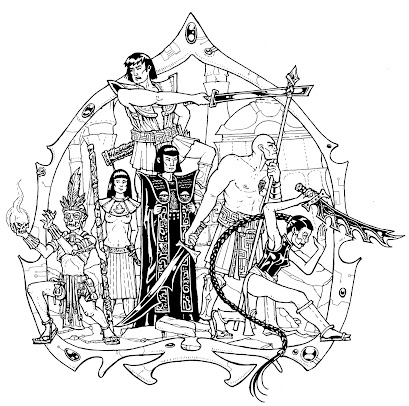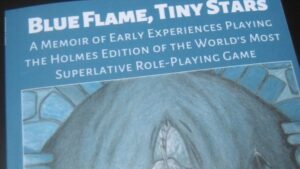The box was among a display of obscure games in a far corner of the shop. The cover art was a colorful map in an ancient style. The colors were blues and reds, yellows and greens.
The map depicted portions of two continents either side a calm sea. The continents were edged in cliffs and sandy beaches. Port cities, fortresses, and temples were drawn in perspective, not the icons I was used to seeing on fantasy maps. Oversize human figures dressed in decorated armor or elaborate garb stood among buildings or sat on them or waded shin-deep in the sea.
My friend came up beside me and followed my gaze.
“What’s that?” I said.
“That’s—” He hesitated. “…An old game. It has a whole world with its own different cultures and languages. It’s kind of weird and complicated.”
“…a whole world with its own different cultures and languages. It’s kind of weird and complicated.”
I picked up the squarish box. Smaller in length and width than D&D’s Basic and Expert Sets, and thinner too, it was heavier than I expected.
I hardly recognized the compass rose in an upper corner, as its four points were marked with curvy glyphs instead of Latin letters. In the lower corner opposite, two figures held an unrolled parchment between them. It read, “Empire of the Petal Throne.” The author was M. A. R. Barker, the copyright date 1975, and the publisher—the only thing I recognized—was Tactical Studies Rules. The spelled out name, already then, signaled a relic from the hoary past.
A small white sticker, rectangular with rounded corners, put the price at $45—far out of my modest reach.
Still admiring the cover, my last question was, “Is it D&D?”
My friend’s response: “Not really.”
I put the box back in its display. We left the shop empty handed.
The image stayed with me though. As did the idea that a fantasy setting could have its own unique cultures—apart from medieval European—as well as languages. And during the 2000s, when I had a salaried job and a mounting interest in old-school games, the 1975 edition of Empire of the Petal Throne did not escape my acquisition.
So when, in 2015, James Maliszewski intoned this popular sentiment, lamented that it was so, and proposed to run a Petal Throne campaign to debunk it, I was in.
Still though, the dense text, sparse black and white drawings, numbered paragraphs, accents hand-drawn into the copy, and names made with awkward syllables stuck together as if they had been speared one by one onto a skewer, like a shish kebab, does not foster comprehension or encourage play.
So when, in 2015, James Maliszewski intoned this popular sentiment, lamented that it was so, and proposed to run a Petal Throne campaign to debunk it, I was in.
House of Worms
Other than one of the initial six players, we were all fresh off the boat, so to speak, on Tékumel, though James did not use the standard barbarians-come-to-Jakálla starting scenario. Instead, the campaign began much like any other. The PCs are Tsolyáni citizens. The campaign is named after the clan to which most player characters belong.
The player with prior experience in the setting is Barry Blatt, who blogs Petal Throne and other RPGs at Expanding Universe. The party looks to his magic-using character, Znayáshu, for guidance. Barry’s expertise has been an assistance to our group of neophytes, though not a crutch. Barry is at times able to expound on the setting’s cultural aspects, saving the GM’s breath, but the details, known to the characters even when the players are ignorant, don’t necessarily save us from any dangers.
Aíthfo hiZnáyu
I generated my character’s personal name using the method Barker describes in a Strategic Review article (Vol. 1, No. 4) “Tsolyáni Names Without Tears.” I cried anyway. The first generated name had five syllables and a comical number of Ss. The lineage name, I chose from a list of families provided by the GM. The prefix “hi,” pronounced hee, translates to “of” in the Tsolyáni language.
Aíthfo is an adventurer (a spell-casting fighter character class of James’s invention). He is motivated by exploration, discovery, and the acquisition of “cash and prizes.” He is most comfortable at the helm of a sailing vessel and in combat.
Travels and Calamities
Over the years, Aíthfo and his clan mates have traveled to the far corners of the planet Tékumel, sometimes of their own accord.
Objects unique to Tékumel are “eyes.” These magically charged devices fit in a palm and are roundish, like a gem, with a stud, which is the trigger, and an aperture, which is the business end. Eyes exist in numerous sorts and of verbose nomenclature. There are, among others, Eyes of Hastening Destiny (which is to say haste) and Being an Unimpeachable Shield Against Foes (invulnerable to weapons), the Splendid Eye of Krá the Mighty (pushes down walls or inflicts six dice of damage), the Terrible Eye of Raging Power (lightning bolt), and the Eye of Creeping Fog of Doom (what it sounds like).
A time early in our careers, in some tight fix and not seeing our way out of it, we decided to test an unidentified eye on our opponents.
Upon finding them, we usually have no idea what they do. A test, by trial and error, is required. But because eyes are so powerful as are their effects diverse, even a trial might go awry. A time early in our careers, in some tight fix and not seeing our way out of it, we decided to test an unidentified eye on our opponents. Instead of destroying the enemy, the Eye of Departing in Safety displaced our entire party to a far corner of the continent in an instant. The return was a picaresque journey across vast deserts and through enemy lands, a veritable sight-seeing tour across Tékumel. Six months passed in the game over about a year of play.
Since then, we have sailed to the Southern Continent, which runs off the edge of the game map, and zipped across the length and breadth of the planet via an ancient underground “tube car” system; we have been to the Battle of Dórmoron Plain, a sort of demi-plane where the gods and their armies fight one another in an eternal war; and we slipped from one time line to another, only once as far as we can tell.
In all our travels, we saved the world from certain destruction a couple times. We may have provoked the destruction once or twice.
Clan Mates
Though our characters began as family, their players were mostly strangers to one another. I suppose it happens faster when the venue is a game table, but after so many years of weekly gatherings with these folks around this small window into a virtual world, where we share co-imagined experiences in a fictional one, we have got to know each other. Though at some distance, we have shared a number of triumphs and tragedies—the best and the worst. I’ve grown to think of the players behind Aíthfo’s clan mates as my own. I am affected by what’s going on in their lives, excited for the good things and concerned for the bad.
Metal-Clad Spell-Casting, Divine Intervention, Resurrection, and Apotheosis
Through Aíthfo, I have experienced a number of iconic moments in fantasy role-playing. The least of which is becoming governor of a remote province, the classic domain ruler.
Aíthfo once cast a spell through the blade of a sword while wearing armor, both metal. When he did not survive, priest and clan mate Keléno called for divine intervention. This failed, but not before sword and armor, both also magical, were sacrificed. The party, far from home, negotiated with a local cult to have him raised from the dead. The deal was that Aíthfo, once raised, would be invested by an aspect of their god. After his raising, he found he could speak the local language and see magical auras. Later, this divine power was sapped to halt the invasion of the planet by a malign deity.
The adventurer was his old self again until recently, when he suffered a critical hit. An attack roll result of 20, in Petal Throne, deals double damage to the target and triggers a second roll. On this roll, a 19 or 20 kills. We count four instances when a party member has defeated an opponent by this rule. Aíthfo was the first of us to be on the other end of it.
For Aíthfo, though, the game is not over. He was returned to life a second time. This time through some divine power, possibly a vestige of the god still within him. We haven’t quite figured that one out yet. Now, he has a heightened sense of military strategy and an unreasonable fear of fish.
It’s about time he begins work on an autobiography. Working title: “The Life and Deaths of Aíthfo hiZnáyu.”

The cast of original characters: Aíthfo, at top, and from left to right, Znayáshu, Ssúri, Keléno, Grujúng, Jangáiva.
This drawing by Zhu Bajiee appears on the cover of The Excellent Traveling Volume, No. 6. There are so far 13 issues of Maliszewski’s old-school fanzine dedicated to Empire of the Petal Throne.
Anniversary
House of Worms’ numbered sessions are scheduled every Friday. We play when at least four players are in attendance. When not, we usually fill the two-hour period with friendly game chatter.
Being an online game, I get an invitation every week for “House of Worms.” My habit is to respond Yes and delete the message from my inbox. So, every week at game time, when I need the meeting link, I search “in: trash worms.”
This week, we celebrate seven years of the House of Worms campaign. Today’s is session 259. As it is also GMs Day, let me say, James, on behalf of myself and my House of Worms clan mates, thank you for showing us that, while Empire of the Petal Throne remains weird and complicated, it is wonderfully so, and it isn’t as inaccessible as its reputation might lead us to believe.
House of Worms Elsewhere
Grognardia:
Dyson Logos’s reflections on the game and the campaign:
